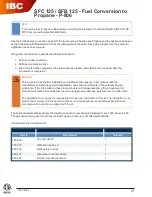
24
PHTM II
Combi Installation, Operating & Service Instructions
110331-07 - 8/23
8
Sidewall Direct Venting
WARNING
Asphyxiation Hazard.
•
Follow these instructions when determining
vent terminal location. Failure to comply
could result in severe personal injury,
death or substantial property damage.
• A gas vent extending through an exterior wall
shall not terminate adjacent to a wall or below
building extensions such as eaves, parapets,
balconies, or decks.
!
1. Do not exceed maximum equivalent vent and
air pipe length in Table 7-7.
2. Consider surroundings when selecting terminal
location:
A. Locate terminal so flue gas will not damage
nearby plants or air conditioning equipment or
be objectionable to building owner.
B. During cold weather, a visible cloud of flue
gases will be emitted from terminal. Avoid
areas where this could obstruct window view
or be otherwise objectionable.
C. Flue gas may condense or freeze causing
water or ice buildup on objects surrounding
structure. Move or protect these objects if
they are subject to damage from condensate.
D. Avoid possibility of accidental contact of flue
gas with people or pets.
E. Avoid locating terminal where wind currents
could affect performance or cause
recirculation. Areas to avoid include inside
building corners, near adjacent buildings or
surfaces, windows wells, stairwells, alcoves,
courtyards, or other recessed areas.
3. Locate terminals so they are not likely to be
damaged by foreign objects such as stones or
balls, or subject to buildup of leaves or dirt.
4. Maintain clearances to vent terminal per
Figure 8-1.
A. Minimum 12 in. (305 mm) from any door,
window or other gravity air inlet.
B. Minimum 3 ft. (900 mm) above any forced air
inlet located within 10 ft. (3.1 m).
C. Minimum 12 in. (305 mm) from inside corner.
6 ft. (1.8 m) is generally recommended and
required when window and/or air inlet is within
4 ft. (1.2 m) of inside corner.
D. Do not locate terminal above a public
walkway.
E. Minimum 12 in. (305 m) below roof overhang.
Close proximity to overhang and/or a deep
overhang requires vent terminal to protrude
farther from wall.
F. Minimum 4 ft. (1.2 m) in USA or 6 ft. (1.8 m)
in Canada from any electric meter, gas meter,
regulator, or relief equipment. Never terminate
above or below any of these within 4 ft. (1.2
m) horizontally.
G. Vent and air terminals minimum 12 in.
(305 mm) above grade or normal snow line, if
applicable.
5. Do not locate vent terminal under decks or
similar structures.
6. Avoid locating combustion air terminal in an
area with or likely to have contaminants. See
Table 5-2.
NOTICE:
Minimize lengths of piping outside
building to reduce risk of condensate freezing in
vent pipe causing boiler shutdown.
Prepare Wall Penetrations
1. Use base plate (if applicable) to determine air
and vent pipe hole centerline locations.
2. Cut hole for air pipe as close as desired to pipe
outside diameter.
3. Cut hole for vent pipe at least 1 in. (25 mm)
larger than pipe outside diameter following
required clearance per Figure 5-1.
4. Ensure vent wall penetration and methods of
securing and sealing around terminal allow for
thermal expansion.
Determine Terminal Location
















































